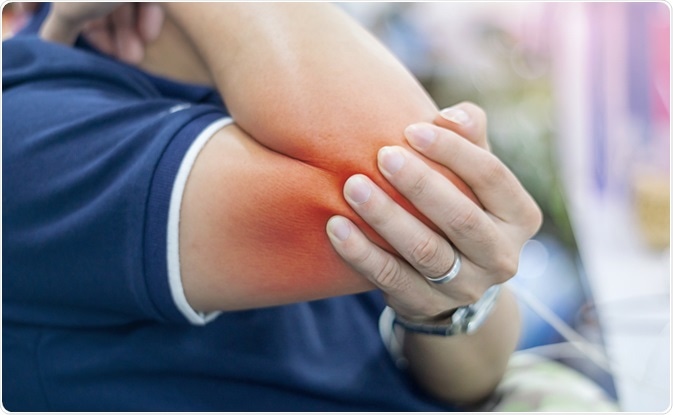The ideal treatment of tennis elbow involves a combination of lifestyle changes and light therapies to aid the healing of the affected muscles and tendons. Allowing the muscles to rest is essential and the vast majority of patients find that their symptoms improve without the need for surgical treatments.

Image Credit: I'm friday / Shutterstock.com
Lifestyle modifications
Initially, the most important steps to managing the symptoms of Tennis Elbow are simple lifestyle changes that promote the natural healing of the muscles and tendons in the area.
Where possible, the muscles in the forearm should be allowed to rest completely by ceasing the activities that were likely to cause the condition. In some cases, this is not possible, however, due to causative activities that are work-related, which may require some modifications to help reduce the pressure on the area.
For example, an elbow brace may be beneficial to support the area and reduce the tension on the tendons. Similarly, changing the technique or equipment used can also help to improve the condition, such as the racquet used while playing tennis.
7 Best Tennis Elbow Pain Relief Treatments (Lateral Epicondylitis) - Ask Doctor Jo
Pharmacological treatments
Most patients find that the pain associated with tennis elbow is the most troublesome symptom and, therefore, often seek relief for this. Nonsteroidal anti-inflammatory drugs (NSAIDs) such as aspirin or ibuprofen are most commonly recommended due to their analgesic and anti-inflammatory properties.
For more severe cases, cortisone steroid injections may provide stronger anti-inflammatory action and help to reduce the swelling and pain in the area. This should not, however, be considered as a long-term approach. To this end, a maximum of three injections should be administered over time.
Physical therapy
Physical therapy involves certain exercises to help in strengthening the muscles and subsequent improvement of the condition. It is suggested that patients be referred to a physiotherapist for individualized recommendations to help improve their symptoms.
In the initial stages of physical therapy, exercises that promote healthy movements and stretching of the muscles will typically be used. As the therapy progresses, exercises that are intended to strengthen the muscles are incorporated into the patient's routine. There are several different types of exercises that may benefit the patient and relieve their symptoms.
In addition to these exercises, physical therapy may include other approaches such as ultrasound, heat, or ice treatments. These mediums can be applied directly to the area to reduce the pain and promote healing.
Shockwave treatment
Treatment with extracorporeal shockwave therapy is a relatively new development that uses shock waves directed towards the elbow and affected tissues. These waves lead to “microtrauma,” which promotes natural healing in the body.
This is a relatively successful treatment approach and has been found to help improve symptoms for approximately 60% of patients with tennis elbow. For this reason, shockwave therapy is a second-line option that should be considered after pharmacological and physical therapies, but before surgical treatments, which carry a higher degree of risk.
Surgical treatment
The vast majority of patients with tennis elbow do not require surgery; however, surgical intervention can be an effective solution for individuals who are not successful with other treatments.
Typically, surgery will involve the removal of the diseased tissue, which is then replaced with new and healthy tissue. There are two techniques currently used in practice, both of which are performed as outpatient procedures. These surgical techniques include open surgery and arthroscopy, which are performed with a large incision into the elbow, or through the use of several instruments that are inserted into smaller incisions, respectively.
Rehabilitation therapy is usually required in the weeks and months following surgery. Initially, the new muscles should be stretched softly to improve movement in the area. Strengthening exercises can be introduced approximately 8 weeks following surgery and individuals may return to full athletic activities within 4-6 months.
Developing treatments
Additionally, some treatments are being investigated for use in the future to help people with tennis elbow. For example, the administration of platelet-rich plasma (PRP) may help to speed the natural healing process. The current research supporting this treatment is promising, although further research is necessary before it becomes a reality in practice.
References
Further Reading